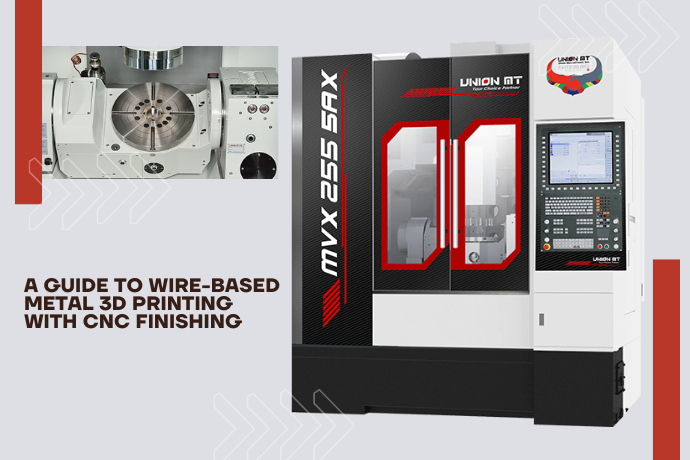Hybrid Manufacturing Powerhouse: WAAM & CNC Integration

Wire-based metal 3D printing (commonly referred to as Wire Arc Additive Manufacturing, WAAM) is redefining how large metal parts are produced. As a Directed Energy Deposition (DED) process, WAAM offers high deposition rates and utilizes more affordable wire feedstock, providing a more cost-effective solution compared to Powder Bed Fusion (PBF) systems (such as DMLS or SLM).
However, WAAM parts are produced in a "Near-Net Shape" with high surface roughness and limited precision. This makes Precision CNC Turning finishing an indispensable step in the overall additive manufacturing workflow.
As a precision CNC equipment manufacturer, Union Mechatronic Inc. (Union MT) is committed to providing high-accuracy CNC machine tools for customers adopting this Hybrid Process, ensuring WAAM parts meet final engineering specifications.
WAAM Cost-Benefit Analysis: Per-Part Cost Breakdown
WAAM part costs typically range from $50 to over $10,000, mainly depending on part size, wire material, welding system configuration, and CNC post-processing requirements.
1. Part Size and Complexity
WAAM is particularly well-suited for manufacturing large structural components with low to moderate complexity, such as aerospace components, turbine blades, or large structural beams.
| Part Type | Estimated Cost Range (Per Part) | Notes |
|---|---|---|
| Small WAAM Parts | $50 – $500 | Suitable for small tooling or test blocks |
| Large Parts (30–100 kg) | $1,000 – $10,000+ | Suitable for structural frames or large prototypes |
Compared to powder-bed processes, WAAM allows for thicker layers and faster build times, which significantly lowers the cost per kilogram of manufacturing.
2. Wire Material Costs
Wire feedstock is generally much more affordable and easier to handle than metal powders, making it a safer and more efficient material option.
| Material Type | Estimated Cost (Per Kg) |
|---|---|
| Mild Steel / Stainless Steel | $3 – $15 |
| Aluminum | $20 – $80 |
| Titanium Alloys | $150 – $400 |
3. System and Operation Costs
WAAM systems typically utilize robotic arms or gantry configurations for the additive process.
- WAAM System Cost: $50,000 – $300,000
- Operating Cost: $5 – $30/hour (depending on energy consumption, wire feed rate, and shielding gas usage)
Union MT's Solution: Union MT directly supports WAAM post-processing needs for long and large near-net shape parts by offering tools like Traveling Column Milling Machines and 5-Face Machining Centers.
From Near-Net Shape to Final Precision: The Crucial Role of CNC
Despite WAAM's excellent deposition efficiency, the resulting parts often exhibit poor surface finish (rough) and large tolerances. Precision CNC finishing is necessary to ensure parts achieve engineering-grade performance.
WAAM parts typically require the following post-processing steps:
- Heat Treatment (e.g., Stress Relief): To mitigate internal residual stress generated during the manufacturing process.
- CNC Rough and Finish Machining: Using high-rigidity CNC machine tools to remove excess material and achieve precise dimensional tolerances.
- Surface Grinding or Polishing: To further improve surface finish.
Precision CNC finishing is an indispensable part of WAAM hybrid manufacturing. Only by combining the speed advantage of additive manufacturing with the precision of CNC can truly applicable final products be produced.
How Wire Arc Additive Manufacturing Reduces Lead Time
WAAM accelerates the production of structural components by eliminating the need for molds or casting, which is especially valuable for emergency and large-scale prototyping.
1. Faster Build Rates
WAAM offers deposition rates that are 5 to 10 times faster than traditional powder bed fusion, making it an ideal choice for urgent repairs and mass prototyping.
2. No Tooling Required
Parts are manufactured directly from digital models, making the process well-suited for custom brackets, mounts, and small-batch tooling bases.
3. Local, On-Demand Fabrication
WAAM systems can be deployed close to the point of use, which is particularly valuable for supply chains in defense, offshore engineering, and aerospace that require rapid response.
WAAM vs. CNC Machining: Use Cases Compared
| Factor | Wire Arc Additive Manufacturing (WAAM) | CNC Precision Machining (Union MT) | Hybrid Manufacturing Advantage |
|---|---|---|---|
| Part Size | Large, heavy structural components (10+ kg) | Small to large, high-precision parts | WAAM builds the large base, CNC handles critical features |
| Material Form | Wire Feedstock | Solid bar, billet, or cast block | Combines cost-effective raw materials with high-precision tools |
| Process Speed | High Deposition Rate, suitable for quick stacking | Slower, focused on precision | Achieves a balance between speed and accuracy |
| Surface Finish | Rough, requires machining | High Quality, single-pass output | Meets demanding surface requirements |
| Final Precision | Moderate tolerance before machining | High Precision (±0.005 mm or better) | Ensures final parts comply with strict industry standards |
| Best Use | Prototypes, structural frames, repair parts | Final finishing, tight tolerance components |
Union MT: Your WAAM CNC Finishing Partner
Union MT is dedicated to supporting the complete wire-based additive manufacturing workflow by offering CNC platforms and Multi Spindle Machines specifically designed for Hybrid Manufacturing Environments:
- Flat-bed CNC Lathes: Suitable for turning operations after printing.
- 5-Axis Machining Centers: For efficient machining of complex or asymmetric WAAM components.
- Heavy-Duty CNC Turning Centers: For processing large diameters and hard-to-machine alloys.
- Automatic Pallet Changers: Significantly enhance post-processing efficiency and automation.
Are you looking to integrate the speed of WAAM with the high precision of CNC machining in your production line?
Explore Union MT's CNC platforms, purpose-built for hybrid manufacturing environments that demand Accuracy, Speed, and Seamless Integration.